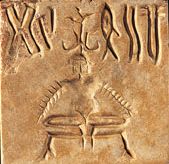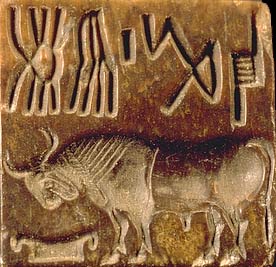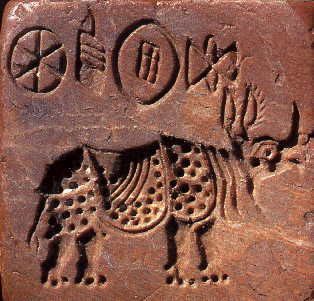This article is a continuation of the previous article Aacharan and is supposed to be read in that order.
The Indus people believed in the Supreme Being whose quiescent attributes were omniscience, benevolence and power of generation and destruction. The Supreme Being had three eyes and eightfold form. His names were Iruvan, Enmai, Tandavan, Munkan. The Dravidians worshipped Linga in the temples, the Linga which was the amorphous representation of Shiva. They worshipped Linga by sprinkling it with water or milk, by offering prayers, by meditating on the deity. Shiva had the emblems, namely, the trident, the snake, the axe which are still the characteristic emblems. They had an idea of death and judgement after death which was the basis of moral life. But to crown all these, they had a concept of the Triad – An, the Supreme Godhead; Amma, the Goddess; and Anil, the Son. These are the later day Shiva, Shakti and Sharana of the Agamas. Madame Blavatsky in her Key to Theosophy says that theosophy means divine wisdom or Brahmavidya and it comes to us from the Alexandrian philosophers called the lovers of truth. The name theosophy dating from the third century A.D. began with Ammonius Sacas and his disciples who started eclectic theosophical system. They were also denominated Neoplatonists. But its origin is much earlier as it is attributed to the Egyptian priest, Pot Amun, who lived in the early days of the Ptolemaic dynasty. Diogenes says that the name is coptic and signifies one consecrated to Amun, the God of wisdom. Here we venture to say that Amma, which is the correct form of Amun, is not originally the Egyptian deity. In reality it belongs to India and especially to Dravidians in whose trinity Amma constitutes the middle term. Amma, Uma, Maya, Mata are all cognate terms implying the divine power and wisdom of An or Shiva, the transparent Reality.
Another name of Shiva is An which becomes clear from the evidence obtained in the Puranas and Epics. The Mahabharat refers to Anu which means Shiva. The words Anu, Sthanu and Anudharma imply the religion of Shiva. Father Heras observes: “The word An – Shiva – travelled to Sumer, Egypt and other countries. The word Anu, in the feast of the striking of Anu in Egypt, is actually connected with the followers of An – Shiva.”
Dravidians lived not only in the Indus Valley and the Deccan but were spread all over India. They had developed their civilization and language and had commercial relations with Egypt, Chaldea and other Mediterranean countries. It has now been proved that the names of certain articles which King Solomon’s trading ships brought him, were not originally Hebrew. These articles are sandalwood, ivory, peacocks, apes and teak, which could easily be traced through the Hebrew corruptions, have all along been set down as Dravidian words. In the ruins of the ancient Ur of the Chaldeas, built by Ur-Ea, the first king of the united Babylonia who ruled 3000 years BC, was found a piece of Indian teak and it is to be noted that teak grows on southern India from where it was exported to Babylonia. These facts simply point to a well-established commercial intercourse between the Dravidian India and Babylonia. It is but natural that with the export of commercial commodities, the cultural ideas must also have been exported into Chaldea from the Dravidian India. One of the cultural ideas that dominated the Chaldean mind was Minkan. In the Dravidian religious life Minkan or Fish-eyed represents the Supreme Deity. We read in the story of Chaldea that Fish-God is the civilizer of Chaldea.
Dravidians lived not only in the Indus Valley and the Deccan but were spread all over India. They had developed their civilization and language and had commercial relations with Egypt, Chaldea and other Mediterranean countries. It has now been proved that the names of certain articles which King Solomon’s trading ships brought him, were not originally Hebrew. These articles are sandalwood, ivory, peacocks, apes and teak, which could easily be traced through the Hebrew corruptions, have all along been set down as Dravidian words. In the ruins of the ancient Ur of the Chaldeas, built by Ur-Ea, the first king of the united Babylonia who ruled 3000 years BC, was found a piece of Indian teak and it is to be noted that teak grows on southern India from where it was exported to Babylonia. These facts simply point to a well-established commercial intercourse between the Dravidian India and Babylonia. It is but natural that with the export of commercial commodities, the cultural ideas must also have been exported into Chaldea from the Dravidian India. One of the cultural ideas that dominated the Chaldean mind was Minkan. In the Dravidian religious life Minkan or Fish-eyed represents the Supreme Deity. We read in the story of Chaldea that Fish-God is the civilizer of Chaldea.
Apart from this historical significance, Minkan has a metaphysical meaning fruitful for investigation. Minkan signifies ever vigilant vision that carries with it ever vigorous execution. Shiva is therefore the Godhead that has the inherent power of effective will and intuitive knowledge which unmistakably refers to the divine Shakti or Amma as a counterpart of An or Shiva. The Agamas wax eloquent upon this inherent relation of Shiva-Shakti and Linga represents the unifying principle of Shiva-Shakti, of being and becoming, of truth and will. The Agamas evidently emphasize the dynamic principle Shakti which is integrally associated with Shiva. But Shiva transcends Shakti in the sense that the remains calm while Shakti is the moving principle. Shakti is immanent in Shiva and it is the force of projection in creation and the force of withdrawal in liberation, through the emphasis on the principle of becoming. The Agamas, unlike Bergson, insist upon the locus of becoming to a centre. Becoming or dynamism is the ideal unfolding of the divine but behind this ideal unfolding stands Shiva – the Supreme consciousness which energizes this ideal unfolding. Shakti is the source of all possibilities – spiritual, psychic and vital, both cosmic and individual. Shiva is beyond all actuality and possibility.
In mystic experience there is a tendency in man to become God and a contrary tendency in God to become man. Without these tendencies there can be no spiritual life in the concrete. Indeed the mystery of concrete spiritual life implies a fulfillment through contradiction. Virashaivism which preserves the triad of An, Amma and Anil in the crystallized form of Shiva, Shakti and Sharana, also exhibits this contradiction. The Son, Sharana, becomes God Shiva; the divine Mother Shakti reveals the Shivahood, where the sonship is sincere and complete. The Son becomes the Father even as the Father becomes the Son through the intervention of the Mother. Allama Prabhu, the Virashaiva master mystic was the best representative of this sonship. One of his sayings runs thus: “Father produced me through the Mother and I became identified with the Father through the Mother.” This cryptic saying suggests that the Son or Sharana who is the divine individual, has to attain Shivahood who is the transcendent Divine, through the medium of Shakti, the universal Divine.
This article 'Historical Aspects of Shiva-yoga' is taken from H.H.Mahatapasvi Shri Kumarswamiji's book,'Technique of Opening the Third Eye'.





No comments:
Post a Comment